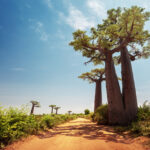
Northern Madagascar
July 6, 2021
What To Look Forward To On A Madagascar Holiday
September 13, 2023
Northern Madagascar
July 6, 2021
What To Look Forward To On A Madagascar Holiday
September 13, 2023
Southern Madagascar is hugely rich in wildlife, diverse in scenery and abounds with culture.
Although with the RN7 route (the main road from the capital Antananarivo to the south-west town of Tulear) included within its confounds as one of the most popular tourist routes, there are some truly superb off the beaten track areas we highly recommend to our clients. There are three main areas of interest in this broad Southern part of the country that we have 'grouped together' for ease of understanding, Isalo National Park and Zombitse National Park, Tulear and Ifaty, as well as Ifotaka Community Forest and Sainte Luce Bay.
Southern Madagascar FAQs
There are some real off the beaten track hidden gems in the southern part of Madagascar. The main road (RN7) takes you straight from the capital into the heart of the south-west to a town called Tulear. You can experience the true culture of Madagascar and it's people in the south.
Along the RN7 you will also find Isalo National Park and Zombitse National Park, where you will find sandstone rocks and deep canyons, rare endemic plants, as well as a multitude of bird species. Also near Tulear and Ifaty you can see the famous spiny forest and more baobabs. There are also several beach destinations here to enjoy snorkelling, diving, surfing, kite surfing and other boat trips.
Near the deep south is Fort Dauphin there are two of our favourites places, Ifotaka Community Forest and Sainte Luce Bay, where you can see 22,000 ha of spiny forest, great wildlife and a secluded tropical paradise with untouched beaches.
Southern Madagascar is an arid region which has a dry tropical climate with very little rain. The only period that experiences a bit of rain is from January to March. The rest of the year is almost completely dry, especially on the southwestern coast South from Tulear, which is the driest area of the country.
Temperatures get really high from February to May and between October and December (30° average), so be prepared for a burning sun during this period. The nicest period is during the winter, from June to September, when the temperatures are around 25°C.
SOUTHERN MADAGASCARAREAS OF INTEREST

On the RN7 we have Isalo National Park and Zombitse National Park. Isalo is one of Madagascar most diverse, with its combination of sandstone rocks cut by deep canyons, eroded spectacular shapes, rare endemic plants, and home of the fascinating Bara tribe. Nearby Zombitse National Parkis a transition forest between the western and the southern habitat types, rich in biodiversity and outstanding for birdwatchers. Our picks for accommodation here are Isalo Rock Lodge and Jardin Du Roy.
Select an accommodation below to find out more.

Further down the RN7, around a 4 hour drive from Isalo, we have the south-western coastal towns of Tulear and Ifaty, home to several small coastal reserves of spiny forest and baobabs, along with several beach destinations with a number of diving and snorkelling excursions as well as kite surfing, surfing and boat trips. Our top pick in the area would be the quirky Bakuba Lodge.
Select an accommodation below to find out more.

Also in the deep south we have the town of Fort Dauphin, accessible really only by air. From here are two of our favourite places in the area - Ifotaka Community Forest and Sainte Luce Bay.
Ifotaka protects 22,000 ha of spiny forest and gallery forest in the remote south of the island. Very few tourists venture here and it is incredibly rewarding to be off the beaten track: you will experience the authentic and wild Madagascar. With two distinctive forest types, 5 species of lemur, including the Verreaux’s Sifaka and Ring-tailed Lemurs, countless birds and reptiles, the wildlife experience here is outstanding.
Sainte Luce Bay is a secluded tropical paradise with excellent wildlife viewing and miles of untouched beaches. There is very little tourism here, but the area is home to some of the last remaining stretches of coastal rainforest in southern Madagascar. It is also one of the best locations to see hump-back whales in Madagascar during the season (June – November). Bottle-nose dolphins can be spotted from the beach year-round. The Sainte-Luce peninsula is the starting point of a mangrove network spanning 40 km towards Fort Dauphin and is intersected by rivers and lakes, with the dramatic peaks of the Anosy mountain range in the background. A truly stunning part of the country with two fantastic accommodations of Mandrare River Camp and Manafiafy Beach & Rainforest Lodge.
Select an accommodation below to find out more.




























